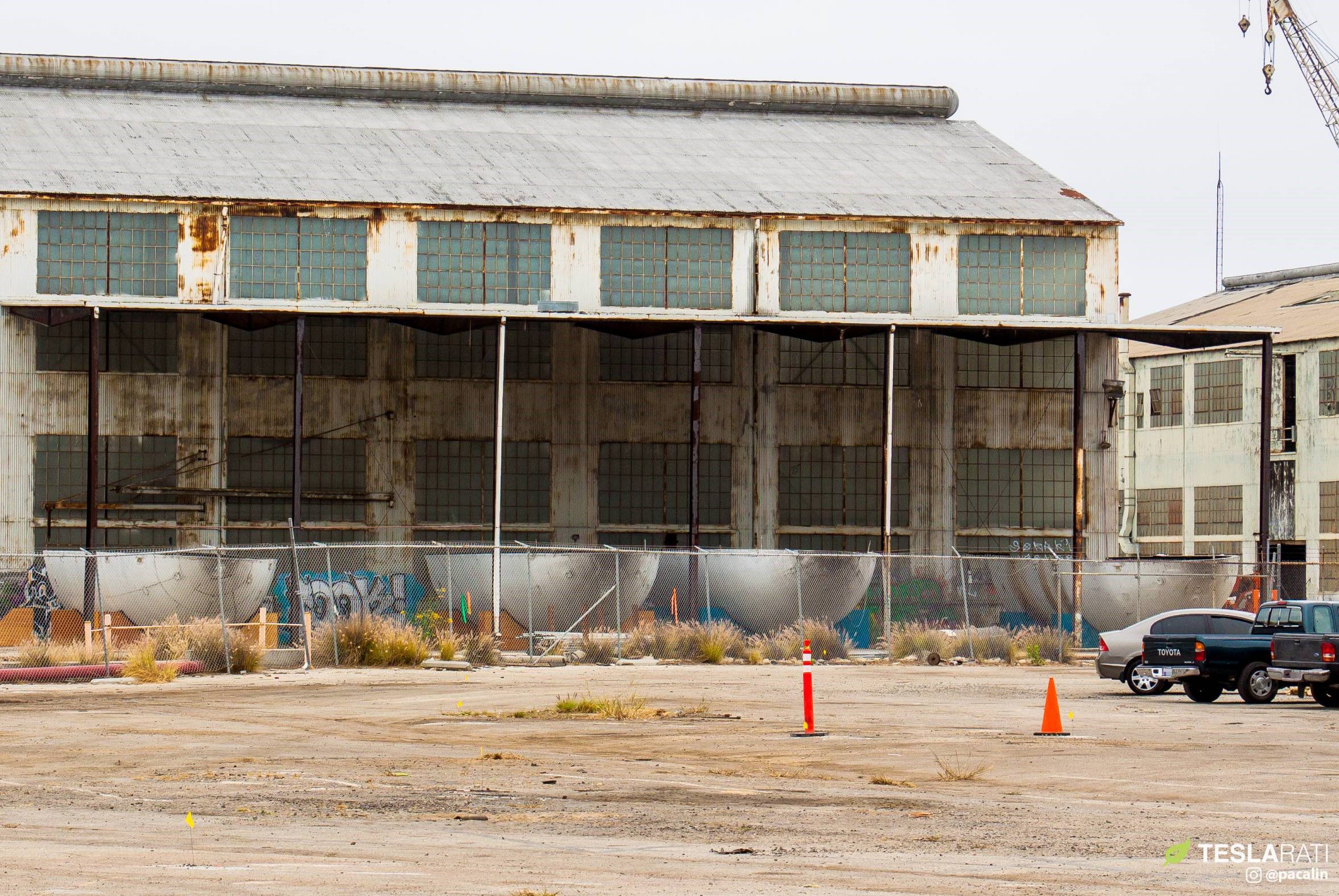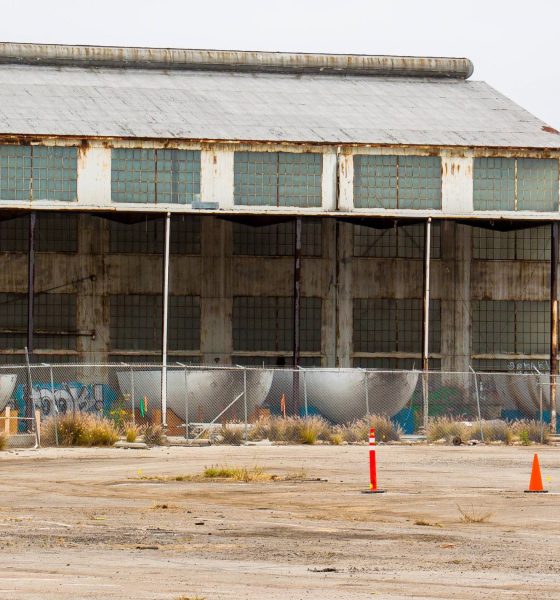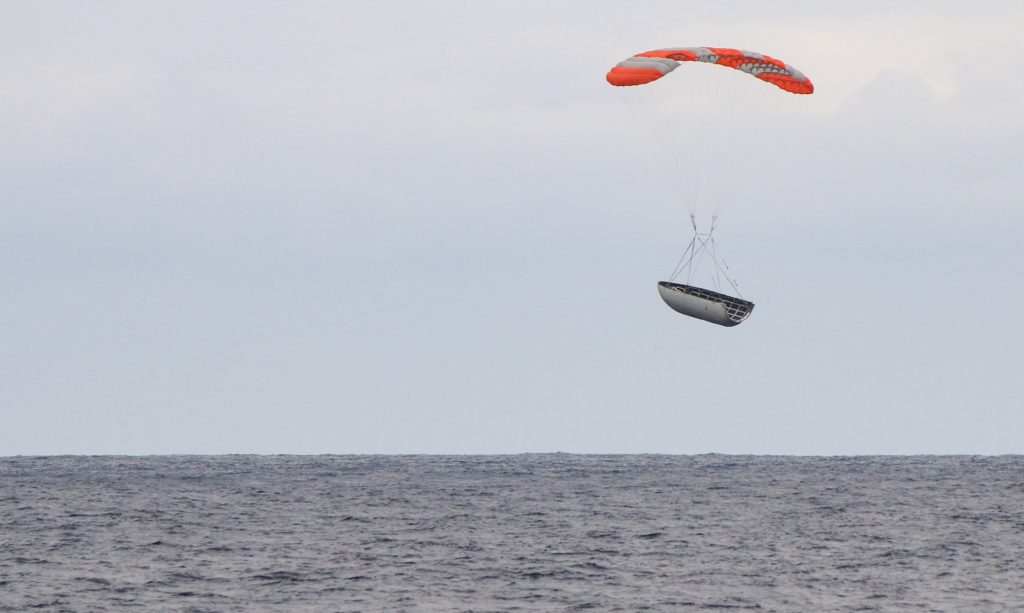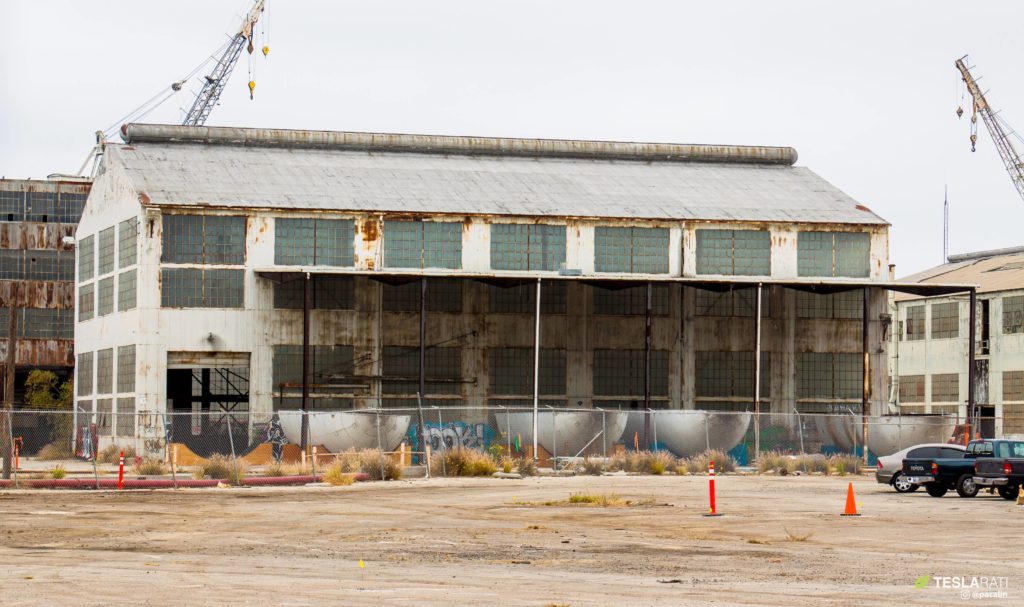

News
SpaceX’s BFR factory in LA spied with four Falcon 9 fairing halves
In an unexpected turn of events, Teslarati photographer Pauline Acalin came across a remarkable scene in Port of Los Angeles – four flight-proven Falcon 9 fairing halves temporarily stored on a plot of land soon to become SpaceX’s dedicated BFR factory.
While it’s difficult to guess exactly which fairing half is which, it appears that the halves from PAZ, Iridium-5, and Iridium-6 are present and accounted for. Reminiscent of SpaceX’s late-2016, early-2017 struggles with finding enough space to store their massive flight-proven Falcon 9 boosters, these fairing halves are unable to be reused as a consequence of too much saltwater exposure, making it significantly easier for the company to effectively find any old plot of SpaceX land on which to store them.

A massive panorama of Berth 240 shows the abandoned shipyard in all its gritty glory, as well as initial construction preparations underway. (Pauline Acalin)
Officially in early 2018, SpaceX is leasing Berth 240 with the explicit intent of constructing a dedicated facility for production of their first Mars rocket prototypes, as well as the relocation of Falcon 9 and Dragon recovery ops, which are quite space-constrained at their current berths. By all appearances, contractor Buntich is staging equipment ahead of initial demolition, refurbishment, and construction operations at Berth 240. Known predominately for pipeline and utility construction and refurbishment, it’s likely that the contractor is in the very early stages of modernizing the decades-abandoned shipyard, particularly, utilities like water, gas, electricity, and more.
- One half of SpaceX’s Iridium-6/GRACE-FO just moments before touchdown on the Pacific Ocean. (SpaceX)
- From left to right, my best guess for each fairing is PAZ, Iridium-6 Half 1, Iridium-5, and Iridium-6 Half 2. (Pauline Acalin)
- Less than a year after SpaceX quite literally scrapped its Port of San Pedro presence, the company is again in talks to build a Starship factory in California. (Pauline Acalin)
It may be fairly clear why SpaceX is storing four massive, unwieldy, and unreusable Falcon 9 fairing halves at Berth 240, but it’s much less clear what exactly their fates will be. With yet another added to the pack just this morning after a successful half recovery post-SES-12, SpaceX’s awkward fairing fleet is likely up to six structurally-intact halves now. These halves could be used for drop testing to perfect fairing recovery accuracy and ensure, at long last, that recovery vessel and claw-boat Mr Steven can catch them out of the air, avoiding the vast majority of exposure to seawater. SpaceX CEO Elon Musk recently noted that Mr Steven’s net would apparently be massively expanded, quadrupling its area to relieve some of the burdens of precision currently placed almost entirely on each payload fairing’s navigational capabilities.
Yup, we are extending the net area by a factor of 4
— Elon Musk (@elonmusk) June 5, 2018
Whether drop testing will actually be conducted is thus unclear, as a decision to expand Mr Steven’s net at least partially indicates that SpaceX engineers are less confident in the each half’s ability to reduce their margins of error by approximately 50%. A quadrupling of usable area implies that Mr Steven’s net will most likely be stretched twofold length-wise and width-wise, or perhaps by 50% for the width and 150% for the length to avoid a need for either an elaborate arm retraction mechanism or a comically unwieldy net.
Either way, Mr Steven’s next fairing catch attempt is unlikely to occur until the Falcon 9 Block 5 launch of Iridium-7, currently no earlier than mid-July. This gives recovery engineers and technicians at least five weeks to refine fairing accuracy and expand Mr Steven’s net, and Pauline will undoubtedly be there to capture any significant developments aboard the eclectic vessel as both it and drone ship Just Read The Instructions prepare for a return to action.

News
Tesla FSD fleet is nearing 7 billion total miles, including 2.5 billion city miles
As can be seen on Tesla’s official FSD webpage, vehicles equipped with the system have now navigated over 6.99 billion miles.

Tesla’s Full Self-Driving (Supervised) fleet is closing in on almost 7 billion total miles driven, as per data posted by the company on its official FSD webpage.
These figures hint at the massive scale of data fueling Tesla’s rapid FSD improvements, which have been quite notable as of late.
FSD mileage milestones
As can be seen on Tesla’s official FSD webpage, vehicles equipped with the system have now navigated over 6.99 billion miles. Tesla owner and avid FSD tester Whole Mars Catalog also shared a screenshot indicating that from the nearly 7 billion miles traveled by the FSD fleet, more than 2.5 billion miles were driven inside cities.
City miles are particularly valuable for complex urban scenarios like unprotected turns, pedestrian interactions, and traffic lights. This is also the difference-maker for FSD, as only complex solutions, such as Waymo’s self-driving taxis, operate similarly on inner-city streets. And even then, incidents such as the San Francisco blackouts have proven challenging for sensor-rich vehicles like Waymos.
Tesla’s data edge
Tesla has a number of advantages in the autonomous vehicle sector, one of which is the size of its fleet and the number of vehicles training FSD on real-world roads. Tesla’s nearly 7 billion FSD miles then allow the company to roll out updates that make its vehicles behave like they are being driven by experienced drivers, even if they are operating on their own.
So notable are Tesla’s improvements to FSD that NVIDIA Director of Robotics Jim Fan, after experiencing FSD v14, noted that the system is the first AI that passes what he described as a “Physical Turing Test.”
“Despite knowing exactly how robot learning works, I still find it magical watching the steering wheel turn by itself. First it feels surreal, next it becomes routine. Then, like the smartphone, taking it away actively hurts. This is how humanity gets rewired and glued to god-like technologies,” Fan wrote in a post on X.
News
Tesla starts showing how FSD will change lives in Europe
Local officials tested the system on narrow country roads and were impressed by FSD’s smooth, human-like driving, with some calling the service a game-changer for everyday life in areas that are far from urban centers.

Tesla has launched Europe’s first public shuttle service using Full Self-Driving (Supervised) in the rural Eifelkreis Bitburg-Prüm region of Germany, demonstrating how the technology can restore independence and mobility for people who struggle with limited transport options.
Local officials tested the system on narrow country roads and were impressed by FSD’s smooth, human-like driving, with some calling the service a game-changer for everyday life in areas that are far from urban centers.
Officials see real impact on rural residents
Arzfeld Mayor Johannes Kuhl and District Administrator Andreas Kruppert personally tested the Tesla shuttle service. This allowed them to see just how well FSD navigated winding lanes and rural roads confidently. Kruppert said, “Autonomous driving sounds like science fiction to many, but we simply see here that it works totally well in rural regions too.” Kuhl, for his part, also noted that FSD “feels like a very experienced driver.”
The pilot complements the area’s “Citizen Bus” program, which provides on-demand rides for elderly residents who can no longer drive themselves. Tesla Europe shared a video of a demonstration of the service, highlighting how FSD gives people their freedom back, even in places where public transport is not as prevalent.
What the Ministry for Economic Affairs and Transport says
Rhineland-Palatinate’s Minister Daniela Schmitt supported the project, praising the collaboration that made this “first of its kind in Europe” possible. As per the ministry, the rural rollout for the service shows FSD’s potential beyond major cities, and it delivers tangible benefits like grocery runs, doctor visits, and social connections for isolated residents.
“Reliable and flexible mobility is especially vital in rural areas. With the launch of a shuttle service using self-driving vehicles (FSD supervised) by Tesla in the Eifelkreis Bitburg-Prüm, an innovative pilot project is now getting underway that complements local community bus services. It is the first project of its kind in Europe.
“The result is a real gain for rural mobility: greater accessibility, more flexibility and tangible benefits for everyday life. A strong signal for innovation, cooperation and future-oriented mobility beyond urban centers,” the ministry wrote in a LinkedIn post.
News
Tesla China quietly posts Robotaxi-related job listing
Tesla China is currently seeking a Low Voltage Electrical Engineer to work on circuit board design for the company’s autonomous vehicles.

Tesla has posted a new job listing in Shanghai explicitly tied to its Robotaxi program, fueling speculation that the company is preparing to launch its dedicated autonomous ride-hailing service in China.
As noted in the listing, Tesla China is currently seeking a Low Voltage Electrical Engineer to work on circuit board design for the company’s autonomous vehicles.
Robotaxi-specific role
The listing, which was shared on social media platform X by industry watcher @tslaming, suggested that Tesla China is looking to fill the role urgently. The job listing itself specifically mentions that the person hired for the role will be working on the Low Voltage Hardware team, which would design the circuit boards that would serve as the nervous system of the Robotaxi.
Key tasks for the role, as indicated in the job listing, include collaboration with PCB layout, firmware, mechanical, program management, and validation teams, among other responsibilities. The role is based in Shanghai.
China Robotaxi launch
China represents a massive potential market for robotaxis, with its dense urban centers and supportive policies in select cities. Tesla has limited permission to roll out FSD in the country, though despite this, its vehicles have been hailed as among the best in the market when it comes to autonomous features. So far, at least, it appears that China supports Tesla’s FSD and Robotaxi rollout.
This was hinted at in November, when Tesla brought the Cybercab to the 8th China International Import Expo (CIIE) in Shanghai, marking the first time that the autonomous two-seater was brought to the Asia-Pacific region. The vehicle, despite not having a release date in China, received a significant amount of interest among the event’s attendees.












